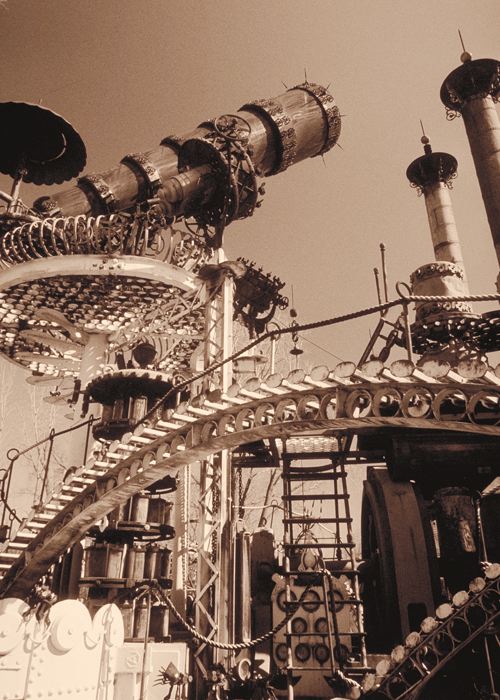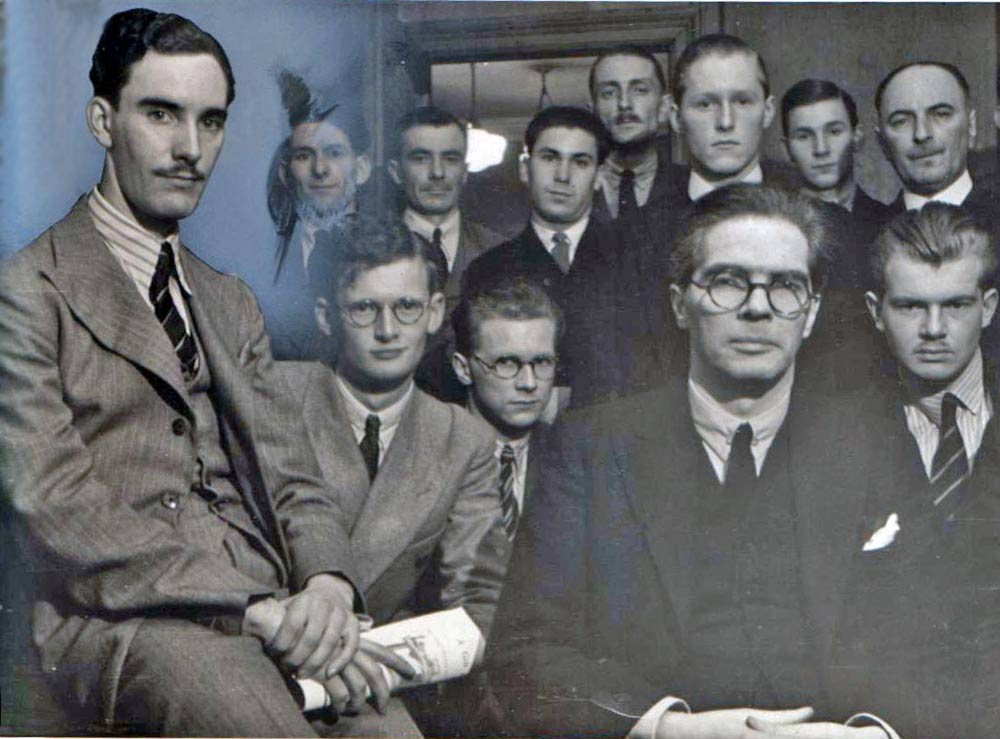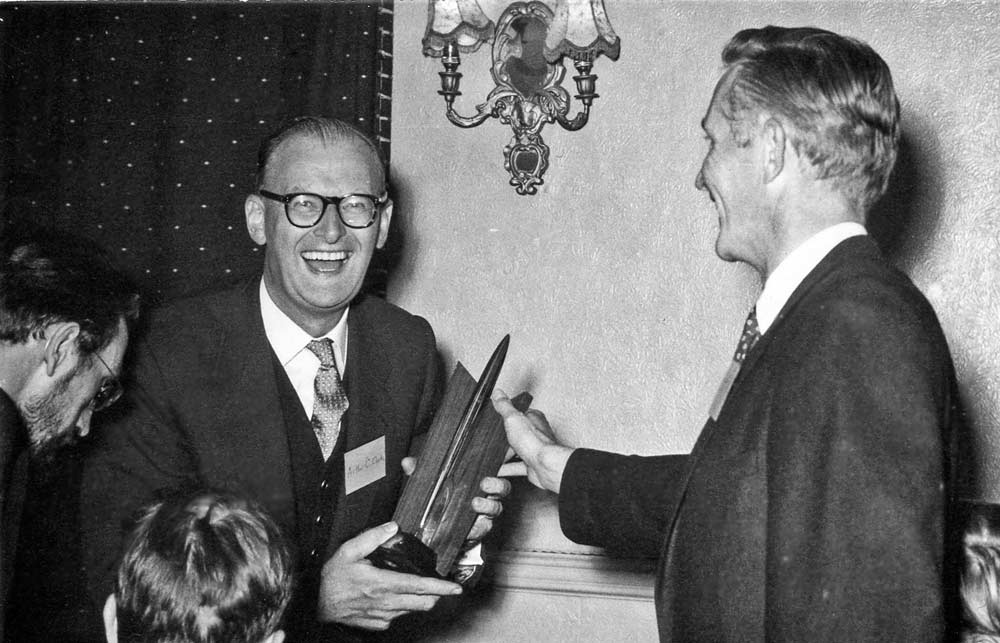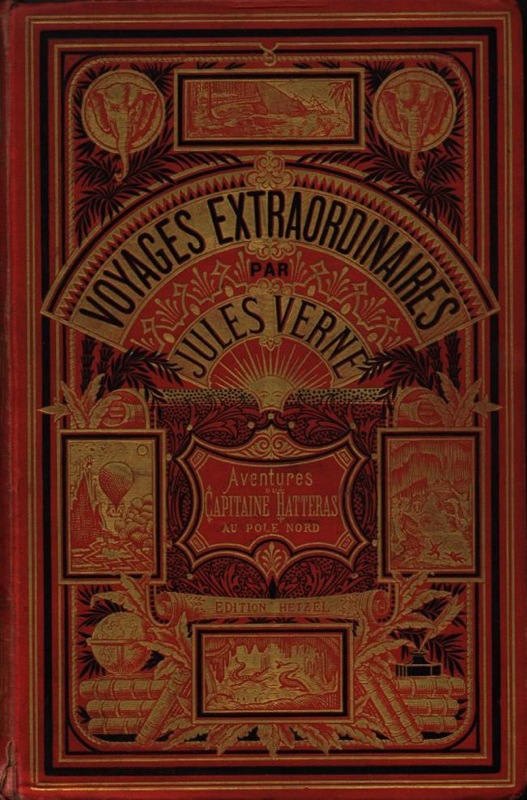skip to main |
skip to sidebar
 Photo: © 2003 Bobbi Lane, used by permission.
Photo: © 2003 Bobbi Lane, used by permission.
‘Dr. Evermor’ is the 19th Century alter ego of former scrap metal dealer Tom Every, who has spent many decades demolishing hundreds of major industrial machines while at the same time turning them into the science fictional landscape known as the Forevertron, the worlds biggest sculpture, situated seven miles south of Baraboo, Wisconsin.
The Forevertron is Every’s improvised monument to late 19th century scientific ingenuity that blends flights of fantasy with reality, and among other things incorporates the Apollo program’s decontamination chamber. As might be expected of a project carried out on such a grand scale the Forevertron also has its own spacecraft known as the ‘Graviton’ – a giant glass ball inside a copper egg – that will take Dr. Evermor to his final face-to-face meeting with God when he “highballs it to heaven”.
 Photo: © 1999 University of Warwick, used by permission.
Photo: © 1999 University of Warwick, used by permission.
Terry Pratchett may have received an Honorary Degree from the University of Warwick on 14 July 1999, but just before that event began he also held a short ceremony to make University of Warwick researchers Prof. Ian Stewart and Dr. Jack Cohen “honorary Wizards of the Unseen University” following the publication of their book The Science of Discworld, which uses Discworld to explain real science.
 Image: Odilon Redon, courtesy of the Museum of Modern Art, New York. (Fair Use)
Image: Odilon Redon, courtesy of the Museum of Modern Art, New York. (Fair Use)
Odilon Redon was born on 20 April 1840, a French artist inspired particularly by the written works of Gustave Flaubert and Edgar Allan Poe. Believing in the superiority of the imagination over observation of nature he rejected Realism and Impressionism in favour of a more personal artistic vision, and his L'Oeil, comme un ballon bizarre se dirige vers l'infini (‘The Eye, Like a Strange Balloon, Floats Toward Infinity’), a lithograph from 1882, was directly inspired by Poe. It has graced the cover of Penguin Books’ The Science Fiction of Edgar Allan Poe since 1976, and the original hangs in the Bibliothèque Nationale in Paris.
 Image: © Paramount Pictures. (fair use)
Image: © Paramount Pictures. (fair use)
The film that launched the careers of both Steve McQueen and Burt Bacharach, The Blob is now a pop culture artifact, written and produced outside of Hollywood with no distribution deal lined up, by people who wanted to do something different with their portrayal of teen culture by depicting teenagers as good kids instead of out-of-control delinquents, which was more customary at the time. It was directed by Irvin S. Yeaworth Jr, a man more accustomed to making religious films. After it was completed a deal was struck with Paramount, who liked it, and The Blob was meant to ship to theatres paired with I Married a Monster from Outer Space, a movie that Paramount justifiably believed would flop. By mistake the distributors ended up shipping The Blob on its own and, unshackled by any association with an inferior movie, its cult status was born on 12 September 1958.
McQueen received only $3,000 for the film; he’d turned down an offer for a smaller up-front fee with 10% of the profits because he didn’t think the movie would make any money, but it ended up grossing $4 million. According to Irvin Yeaworth and Billy Graham, when McQueen died of lung cancer on 7 November 1980 in Juárez, Mexico, he died in a room in which he had also hung a film poster for The Blob.
 Photo: from the collection of E.J. Carnell; text by Peter Weston.
Photo: from the collection of E.J. Carnell; text by Peter Weston.
Science fiction and space travel have always been inextricably entwined, as demonstrated by the first meeting of the London branch of the British Interplanetary Society more than seventy years ago on 28 October 1936. Among the members were Ted Carnell, prominent on the left of the picture, later to become editor of Britain’s most important SF magazine, New Worlds, for 141 issues from 1946-64. In this image – which has been air-brushed at some date possibly for use in a later publication – in the front row to the right of Carnell is the 19 year-old Arthur C. Clarke, at this time newly arrived in London from his native Minehead to work as an auditor for HM Exchequer. Next to him is Walter Gillings, who only a few months later would launch Britain’s very first SF magazine, Tales of Wonder, which ran for five years until 1942. To the right of Gillings is the somewhat older Prof. A.M. Low who had by this time already written his first SF novel, Adrift in the Stratosphere. The Professor became President of the British Interplanetary Society for a period, and this meeting was held in his office in Piccadilly.
 Photo: © 2007 Pete Young, used by permission.
Photo: © 2007 Pete Young, used by permission.
Experiencing a Significant Gravitas Shortfall: born on 16 February 1954, Iain Banks is seen here during an interview for the British Science Fiction Association on 28 November 2007 at Imperial College, London.
 Photo: from the collection of Norman Shorrock; text by Peter Weston.
Photo: from the collection of Norman Shorrock; text by Peter Weston.
Arthur C. Clarke looks delighted to get his first Hugo Award for his short story ‘The Star’ - after waiting twelve months since the 14th Worldcon, in New York, made the award. But finally NyCon chairman Dave Kyle and Clarke managed to be in the same continent at the same time, allowing the presentation to be made at the first London Worldcon in 1957.
As a point of historical interest the 1956 Hugos were only the third set to be presented and were unique for this occasion, being in reality hood ornaments from the Oldsmobile ‘Rocket’ car; look carefully at the picture and you can see how chairman Kyle had cleverly mounted the rockets to hide the fixing details!
 Image: the cover for Jules Verne’s Les Aventures du Capitaine Hatteras au Pôle Nord, type “Aux deux Éléphants”, by Pierre-Jules Hetzel. (public domain); text adapted from Wikipedia.
Image: the cover for Jules Verne’s Les Aventures du Capitaine Hatteras au Pôle Nord, type “Aux deux Éléphants”, by Pierre-Jules Hetzel. (public domain); text adapted from Wikipedia.
Born 15 January 1814, Pierre-Jules Hetzel was the French editor and publisher best known for his discovery of Jules Verne and his extraordinary illustrated editions of Verne’s novels, such as the collected Voyages Extraordinaires (‘Extraordinary Travels’).
Hetzel was to later reject Verne’s 1863 manuscript for Paris in the Twentieth Century because he thought it presented a vision of the future that was far too negative and unbelievable for contemporary audiences, though to many present-day scholars the story was remarkably accurate in its predictions. Verne locked the manuscript away and no longer wrote any futuristic, dystopian stories. Paris in the Twentieth Century was not rediscovered until over a century later, and was first published in France in 1994.
 Photo: © 2003 Bobbi Lane, used by permission.
Photo: © 2003 Bobbi Lane, used by permission. Photo: © 1999
Photo: © 1999 
 Image: ©
Image: ©  Photo: from the collection of E.J. Carnell; text by Peter Weston.
Photo: from the collection of E.J. Carnell; text by Peter Weston.



